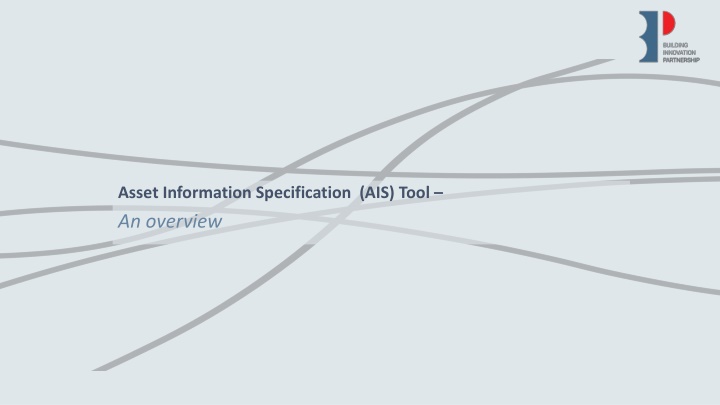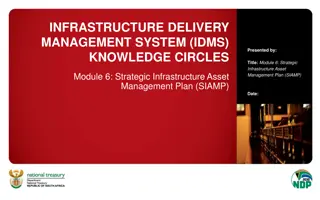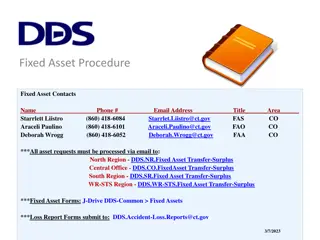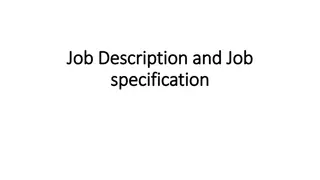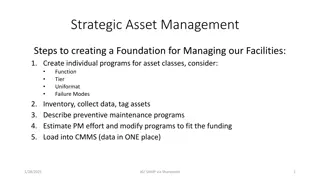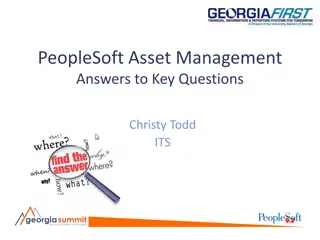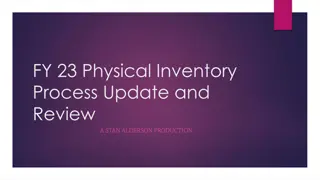Overview of Asset Information Specification Tool
The Asset Information Specification (AIS) Tool addresses disconnects in Asset Management (AM) and Operations & Maintenance (O&M) requirements by providing a framework for owners/operators to define information needs in both human and machine-readable formats. It aligns with existing standards, utilizes Uniclass for classification, and improves the quality and consistency of data delivery. The tool enhances procurement processes, reduces manual errors, and streamlines data handling through standardized requirements.
Download Presentation

Please find below an Image/Link to download the presentation.
The content on the website is provided AS IS for your information and personal use only. It may not be sold, licensed, or shared on other websites without obtaining consent from the author.If you encounter any issues during the download, it is possible that the publisher has removed the file from their server.
You are allowed to download the files provided on this website for personal or commercial use, subject to the condition that they are used lawfully. All files are the property of their respective owners.
The content on the website is provided AS IS for your information and personal use only. It may not be sold, licensed, or shared on other websites without obtaining consent from the author.
E N D
Presentation Transcript
Asset Information Specification (AIS) Tool An overview
Background The AIS tool came to be through recognising: Disconnect between AM and O&M requirements, and their definition in procurement. requirements to BIM. The overarching purpose of the Tool is: Supply chain difficulties in translating client information Client difficulties in validating the information. To provide a tool that allows Asset Owners/Operators to fully define their information needs in both a human and machine readable format, in an as agnostic means as possible. BIM introduced to clients by designers, so BIM capability and control of deliverables has been designer driven. Vast quantities of information needed but no easy way to specify these requirements. Things are improving in quality of procurement documentation Still design heavy. Standards already exist, but the tools and templates to help deliver to those Standards do not. Provides a framework and methodology for asset owner/operators to ask: AIS tool alignment to existing Standards: Encapsulates several sections of ISO19650 parts 1 & 2 1. What asset information do I need? Uniclass chosen as the classification system. 2. Why do I need this asset information? Properties (Attributes) derived from IFC (Industry Foundation Classes), developed by BuildingSMART with some additional added to factor in COBie and Uniclass as the classification system that has been used. 3. When do I need the asset information? 4. Who is best positioned to provide me with the asset information? Export of asset data from BIM uses COBie (Construction-Operations Building information exchange), a Model View Definition (MVD) of IFC.
The Tool AIM tool and ISO19650 Stakeholder requirements Contractual requirements Deliverables Organisational Information Requirements (OIR) Provides the input to Strategy The AIS tool provides the means for an asset owner/operator to traverse along the golden thread. Asset Asset specifies Information Requirements (AIR) Management informs Information Model (AIM) informs Informs Exchange Information Requirements (EIR) specifies Project Information Requirements (PIR) Project Informs Project The golden thread of asset information Information Model (PIM)
Benefits The tool provides a number of benefits including: 1. Standardising the approach for procuring asset information through a machine-readable tool. This means that the process can be easily replicated from project to project, irrespective of who the appointed party is. 2. Improves quality and consistency of data being delivered by reducing the risk for human error. 3. Theoretically should reduce design costs as the need to set up the data schema for each project/client by the designers is removed as it is automated with the tool. 4. Reduces the risk of duplicate data as well as double handling of data. For example clearly specifying who and when is expected to provide the data so as the designers aren t spending time and money trying to provide data that is obviously better placed to be provided by the contractor during the construction phase and there being a doubling up of costs. 5. Provides a very explicit set of requirements for information versus the more generic here s 15 attributes we want for this project irrespective of their relevance for particular asset types (such as the serial number for walls).
OIR The Why Step 1: as an organisation asking why do I need to have this attribute information? Focusing on the data What strategic business need does this asset support? What Level of Service (LoS) is needed to meet the business need? Who is going to manage it? What are their responsibilities? How do I manage this asset? What is the asset? needs for asset management, Owner/operators should try to answer What the following: information is required to deliver to the LoS? What information is required for decision-making? Do I need a model of the asset? asset? What data underpins the information? What level of Information is required? Do I need a model of the You may need to traverse up and down this list How do I manage the information? several times to land on the appropriate answer.
OIR The Why using the Tool Definition Purpose Register A register of assets to support auditing and reporting To support the evaluation of the business case for facility ownership and operation To support the maintenance of health and safety of facility users To enable the comparison of actual use and utilisation with constructed for use and utilisation To support the management of security and surveillance of the facility and/or adjacent sites To support repurposing of the facility/its spaces To support evaluation of the impacts (cost, carbon, energy, waste, water, etc.) of the facility To enable the anticipation of operational cost To enable the anticipation of and planning of costs associated with planned preventive maintenance To enable the anticipation of service life and replacement costs To support anticipation and planning of end-of-life costs Business Questions/case Compliance and regulation Capacity and Utilisation Security and Surveillance Repurposing Impacts Operations Maintenance and Repair Replacement Decommissioning and disposal From ISO19650-1 The Purposes are there to provide the means for an organisation to identify the rationale for needing the various Property information. Business Questions /case Compliance and regulation Capacity and Utilisation ImpactsMaintenance and Repair ReplacementDecommissioning Property Definition Register As can be seen from the sample table, the properties vary both in their purpose to meet the business need (the headings across the top) but also in the property type (ranging from financial, operations and maintenance, to composition). and disposal Field for entering the Asset classification type as per table EF of the Uniclass classification system. Field for entering the Asset classification type as per table Pr of the Uniclass classification system. The serial number assigned to an occurrence of a product. X Type.Category (EF) X X X X X Type.Category (Pr) X X X SerialNumber This highlights the need for all aspects of an organisation to review this sheet so that all use cases for attribute information are considered, and a complete picture built. The date in which the occurrence of the asset type was installed. During construction and handover phase: the manufacturer s suggested retail price for this type. During planning and design phase: not applicable. X X InstallationDate X X X X ReplacementCost Expected service life in years. X X X X X ExpectedServiceLife The mass flow rate of the fluid. X MassFlowRate
AIR The What Using the Tool Step 2: Choose your attribute and classification combos This is the catch all scenario, irrespective of project size and complexity. So whilst it may be a significant task the first time it is completed, for any one client it is then locked in for all future projects. Similarly, if classification and Property combinations can be standardised across the whole industry (forming a Data Standard), then the setup process would be quicker. The use of the classification hierarchy is advantageous in streamlining the selection process. By starting at the highest level, if the condition of suitability is met, then there is no need to populate the child classes of that particular parent, the tool recognises and accounts for the child classes. It could be defined in separate documentation how many levels down the hierarchy are required by a particular client and / or project (for example only wanting assets whose class is Pr_65_52_63 to be classified to level 4 i.e. not the white columns). Only the Properties identified as having a purpose in the OIR sheet are listed here, streamlining the process. Pr_65_52_63_23 - Cross-linked polyethylene (PE-X) collection Pr_65_52_63_33 - Glass fibre-reinforced plastics Ss_50_35_80 - Storm water gravity drainage Pr_65_52_63_22 - Corrugated stainless steel pipes Pr_65_52_63_63 - Polyethylene (PE) water pipes and Pr_65_52_63_03 - Acrylonitrile butadiene styrene Pr_65_52_63_04 - Acrylonitrile butadiene styrene Ss_50_35 - Surface and wastewater drainage Ss_50_35_80_72 - Rigid attenuation or storage tank Pr_65_52_63_14 - Chlorinated polyvinyl chloride Pr_65_52_63_89 - Unplasticized polyvinyl chloride for storm water flood attenuation EF_55_40 - Steam supply EF_55_70 - Water supply EF_55_90 - Piped solids supply EF_55_15 - Water extraction and treatment Ss - Systems fittings EF_55_60 - Process liquid supply All Classifications Pr - Products (ABS) pipe and fittings Pr_65_52_63 - Pipes and fittings pipes and fittings EF - Elements/Functions Ss_50 - Disposal systems (ABS) fittings (PVC-C) pipelines (PVC-U) pipelines Pr_65_52_63_83 - Steel pipeline fittings Pr_65_52_63_18 - Copper pipeline fittings Pr_65_52_63_46 - Lead pipes and fittings EF_55 - Piped supply functions Pr_65_52_63_79 - Stainless steel pipeline fittings Pr_65_52 - Pipe, tube and fitting products Pr_65_52_63_78 - Stainless steel pipelines Pr_65_52_63_25 - Ductile iron pipes and fittings Pr_65_52_63_65 - Polypropylene (PP) pipelines (GRP) pressure pipes and fittings Pr_65 - Services and process distribution products Property Definition Field for entering the Asset classification type as per table EF of the Uniclass classification system. Field for entering the Asset classification type as per table Pr of the Uniclass classification system. The serial number assigned to an occurrence of a product. The date in which the occurrence of the asset type was installed. During construction and handover phase: the manufacturer s suggested retail price for this type. During planning and design phase: not applicable. Expected service life in years. X Type.Category (EF) X Type.Category (Pr) SerialNumber InstallationDate X X X ReplacementCost X X ExpectedServiceLife X X The mass flow rate of the fluid. MassFlowRate
AIR Levels of Information (LOI) Not the same as LOD Where Levels of Detail (LOD) generally cover accuracy and complexity of geometry, LOI s cover the complexity of information regarding an asset. LOI Attribute Definition 2 3 4 5 6 Field for entering the Asset classification type as per table EF of the Uniclass classification system. Field for entering the Asset classification type as per table Pr of the Uniclass classification system. The serial number assigned to an occurrence of a product. The date in which the occurrence of the asset type was installed. During construction and handover phase: the manufacturer s suggested retail price for this type. During planning and design phase: not applicable. Expected service life in years. The mass flow rate of the fluid. Level of Development (LOD) attempts to incorporate both Level of Detail and Level of Information, so caution should be taken to not confuse the two. This term has been adopted predominantly in the US and Australia, whilst the UK and in particular ISO19650-1 uses the term level of information need , which again adds confusion between this and LOI. Type.Category (EF) X Type.Category (Pr) X SerialNumber InstallationDate X X ReplacementCost X ExpectedServiceLife MassFlowRate X Level of Information Need has been further detailed in the Standard BS EN 17412-1:2020 Building Information Modelling Level of Information Need. X The concept of LOI has been developed and maintained by NBS, aligned to Uniclass, but is more of a dictionary , rather than a tool to help define and disseminate requirements. Level Of Information (LOI) 2 3 Definition What is typical for concept stage? A simple description outlining design intent What is typical as the design develops? The specified overall performance of the deliverable What is typical in technical design? The prescribed generic products that meet the desired overall performance requirements What is typical in the construction phase? The prescribed manufacturer products that meet the generic product specification What is typical for operation and maintenance? The key properties to be transferred into an asset database As with AIR section, the intent is to lock in attributes against an LOI as part of a National standard, with there still being the flexibility to modify as required (i.e. the 80/20 rule). 4 5 6
The Who and When Using the Tool Preliminary Design Design LOI LOD IA LOI LOD IA LOI LOD IA EIR Concept Design IA Developed Detailed design LOI LOD IA Construction Operation Project Phase LOI LOD IA LOI LOD AM/OM /FM Project Manager Townplanning/ Traffic Topographical Surveyor EF - Elements/Functions EF_55 - Piped supply functions EF_55_15 - Water extraction and treatment EF_55_30 - Fire-extinguishing supply EF_55_40 - Steam supply EF_55_60 - Process liquid supply EF_55_70 - Water supply Ss - Systems Ss_50 - Disposal systems Ss_50_35 - Surface and wastewater drainage collection systems Ss_50_35_80 - Storm water gravity drainage systems Ss_50_35_80_72 - Rigid attenuation or storage tank for storm water flood attenuation Pr - Products Pr_65 - Services and process distribution products Pr_65_52 - Pipe, tube and fitting products Pr_65_52_63 - Pipes and fittings Pr_65_52_63_03 - Acrylonitrile butadiene styrene (ABS) pipe Pr_65_52_63_04 - Acrylonitrile butadiene styrene (ABS) fittings Pr_65_52_63_14 - Chlorinated polyvinyl chloride (PVC-C) pipelines Pr_65_52_63_18 - Copper pipeline fittings Pr_65_52_63_22 - Corrugated stainless steel pipes and fittings Pr_65_52_63_23 - Cross-linked polyethylene (PE-X) pipes and fittings Pr_65_52_63_25 - Ductile iron pipes and fittings Pr_65_52_63_33 - Glass fibre-reinforced plastics (GRP) pressure pipes and fittings Pr_65_52_63_46 - Lead pipes and fittings Pr_65_52_63_63 - Polyethylene (PE) water pipes and fittings Pr_65_52_63_65 - Polypropylene (PP) pipelines Pr_65_52_63_78 - Stainless steel pipelines Pr_65_52_63_79 - Stainless steel pipeline fittings Pr_65_52_63_83 - Steel pipeline fittings Pr_65_52_63_89 - Unplasticized polyvinyl chloride (PVC-U) pipelines Client ARC 3 PLU 3 PLU 4 BUI 5 SC 6 OM CLI PRO TOW Quantity Surveyor QS TOP Designer /LBP LBP Architect Structural ARC STR Plumbing and Drainage Civil Mechanical Electrical ARC 2 PLU 3 PLU 3 BUI 5 SC 6 CIV MEC ELE PLU Fire Fire Sub- Builder Engineering Protection Contractor FRE FRP BUI SC PLU 4 BUI 5 SC 6 Adopts the same philosophy for LOI as LOD in that: 1. Progression from one LOI to another other doesn t have to be linear 2. Each element doesn t have to start at 2, 3. LOI cannot regress. The LOI and discipline selections are unique for each client and/or project (noting that the Properties have already been tagged against an LOI) Just like the AIR and LOI selections, the disciplines could also be locked in against the classification level to the 80/20 rule, streamlining the review required by the client at the start of each project.
The Who and When Assign a discipline to a Property EIR cont d AM/OM /FM Project Manager Townplanning/ Traffic Topographical Surveyor Client OM CLI PRO TOW Quantity Surveyor QS TOP Designer /LBP LBP Architect Structural ARC STR Plumbing and Drainage Civil Mechanical Electrical CIV MEC ELE PLU Fire Fire Sub- Builder Engineering Protection Contractor FRE FRP BUI SC Recognising that some disciplines may be better positioned to provide data about particular Properties, the tool also has the ability to assign a discipline at an individual property level. A good example would be cost information that would be best placed being provided by a Quantity Surveyor or fire safety rating information for pipes being provided by a fire protection specialist. This sheet is currently optional as the value of having this feature is still being tested but any selections that are made eventually pull through to the QA sheet on the next slide.
QA Quality Assurance Using the Tool Using one single Property as an example, the below workflow shows how each of the sheets are linked to present the final output which the client can use to validate information being delivered during a project. 1) MassFlowRate identified as having at least one purpose within the organisation. 2) MassFlowRate identified as being required for any asset classified as Pr_65_52_63 Pipes and fittings 3) MassFlowRate identified as being required for LOI 6 (What is typical for operation and maintenance? The key properties to be transferred into an asset database) Pr_65_52_63 - Pipes and fittings AIR OIR LOI Capacity and Utilisation Property Definition Property Definition LOI Attribute Definition 6 The mass flow rate of the fluid. MassFlowRate X The mass flow rate of the fluid. X MassFlowRate X The mass flow rate of the fluid. MassFlowRate 5) By selecting the Operation phase from the dropdown, an X appears at the intersection of MassFlowRate and Pr_65_52_63 Pipes and fittings. The discipline also gets populated above the class (Sub-Constractor). 4) For this particular project, Properties designated LOI 6 are required for the operation phase for all assets classified as Pr_65_52_63 Pipes and fittings and that a sub-contractor is required to provide the information for this combination. This can then be used as a machine readable validation tool that can cross-check against information deliverables to ensure requirements have been met. EIR QA Sheet Project Phase Operation IA SC LOI 6 Pr_65_52_63 - Pipes and fittings
Process workflow with Revit 1)Takes selections made by the client 2) Autonomously merges them into BIM authoring software AIR QA Sheet COBie Type Sheet COBie Attributes Sheet 3) Exports data via COBie 4) Can be cross-checked against the QA sheet to ensure data has been populated as per client requirements, at the right time, and who s responsible for delivering that data.
Summary Final Considerations for the Tool Other features of the tool not demonstrated and / or being developed include: Pulls through the definitions into the BIM authoring software (Tooltips in Revit) The ability to assign units of measure and decimal place requirements to numerical properties and these automatically pulling through into Revit. Whether it be in the tool or recommended as separate documentation but having the ability for clients to specify naming conventions (materials labelled as wood versus timber for example). Determining method for incorporating the picklists from the Ifc Enumerated values, where applicable. Ability to search by IfcPropertySet (keywords) and filter by IfcResourceDefinitionSchema and or P_EnumeratedValue Names. Translating this prototype to a web-based platform and having it be BIM software agnostic (e.g. Archicad, Civil 3D, etc.). This will also aid in maintaining the tool for any BIM software and IFC updates that are made. Improving functionality by having an initial selection process for Uniclass classifications so that not all of the ~12,000 classes are in the tool at once. Working on the above, particularly naming conventions and units of measure, will help working towards a national Data Standard and reducing risk of error/inconsistencies of data when developing digital twins without the need for translation/conversion of data from different sources.
